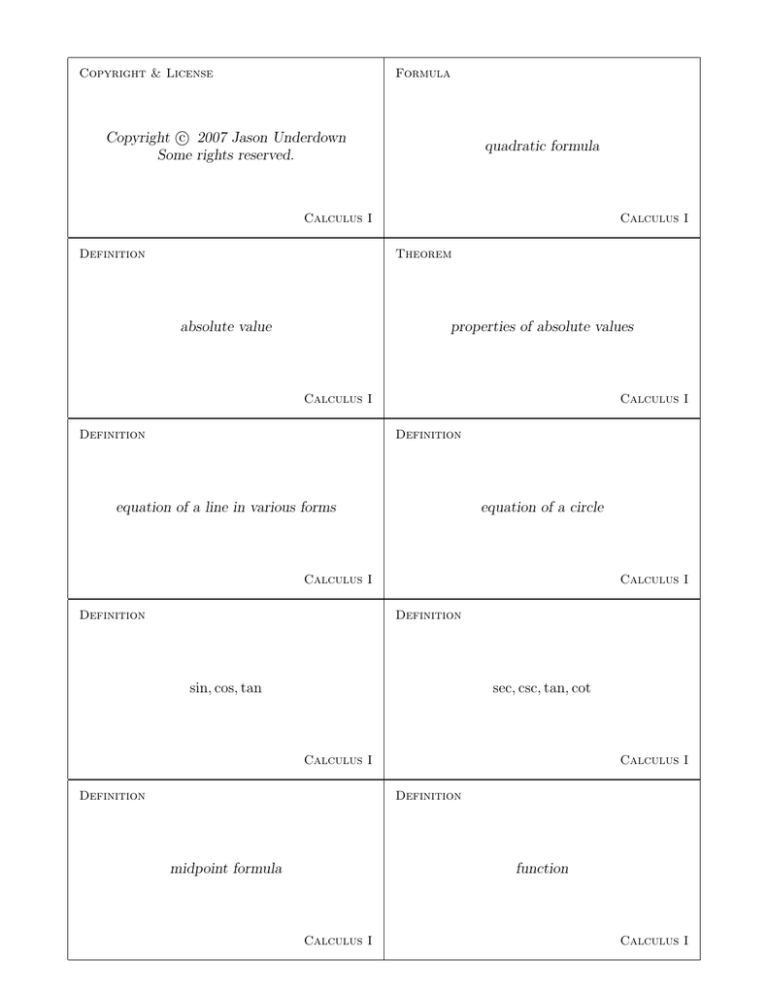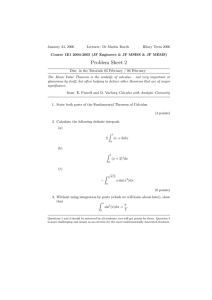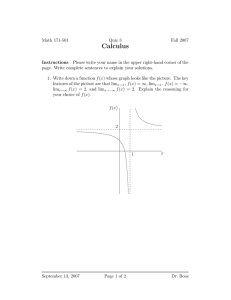
Formula
Copyright & License
c 2007 Jason Underdown
Copyright Some rights reserved.
quadratic formula
Calculus I
Definition
Calculus I
Theorem
absolute value
properties of absolute values
Calculus I
Definition
Calculus I
Definition
equation of a line in various forms
equation of a circle
Calculus I
Definition
Calculus I
Definition
sin, cos, tan
sec, csc, tan, cot
Calculus I
Definition
Calculus I
Definition
midpoint formula
function
Calculus I
Calculus I
The solutions or roots of the quadratic equation
ax2 + bx + c = 0 are given by
√
−b ± b2 − 4ac
x=
2a
These flashcards and the accompanying LATEX source
code are licensed under a Creative Commons
Attribution–NonCommercial–ShareAlike 2.5 License.
For more information, see creativecommons.org. You
can contact the author at:
jasonu at physics utah edu
File last updated on Sunday 8th July, 2007,
at 17:15
1. |ab| = |a||b|
a |a|
2. =
b
|b|
|x| =
x
−x
x≥0
x<0
3. |a + b| ≤ |a| + |b|
4. |a − b| ≥ ||a| − |b||
The equation of a circle centered at (h, k) with radius
r is:
(x − h)2 + (y − k)2 = r2
Form
Equation
point–slope
y − y1 = m(x − x1 )
slope–intercept
y = mx + b
two point
standard
sec θ =
tan θ =
1
cos θ
csc θ =
sin θ
cos θ
cot θ =
1
sin θ
cos θ
sin θ
A function is a mapping that associates with each
object x in one set, which we call the domain, a single
value f (x) from a second set which we call the range.
y − y1 =
y2 − y1
(x − x1 )
x2 − x1
Ax + By + C = 0
opp
hyp
adj
cos θ =
hyp
opp
tan θ =
adj
sin θ =
hyp
opp
θ
adj
If P (x1 , y1 ) and Q(x2 , y2 ) are two points, then the midpoint of the line segment that joins these two points
is given by:
x1 + x2 y1 + y2
,
2
2
Definition
Definition
even and odd functions
limit
Calculus I
Definition
Calculus I
Theorem
limit exists iff both the right–handed and
left–handed limits exist and are equal
one–sided limit
Calculus I
Theorem
Calculus I
Theorem
main limit theorem (part 1)
main limit theorem (part 2)
Calculus I
Theorem
Calculus I
Theorem
squeeze theorem
two special trigonometric limits
Calculus I
Definition
Calculus I
Theorem
point-wise continuity
composition limit theorem
Calculus I
Calculus I
If a function f (x) is defined on an open interval containing c, except possibly at c, then the
limit of f (x) as x approaches c equals L is denoted
lim f (x) = L
even
f (−x) = f (x)
The above equality holds if and only if for any ε > 0
there exists a δ > 0 such that
odd
f (−x) = −f (x)
x→c
for all x
for all x
e.g. x2 , cos(x)
e.g. x, sin(x)
0 < |x − c| < δ ⇒ |f (x) − L| < ε
right–handed limit
lim f (x) = L
x→c+
lim f (x) = L ⇔ lim f (x) = lim f (x) = L
x→c
x→c−
x→c+
iff for any ε > 0 there exists a δ such that
0 < x − c < δ ⇒ |f (x) − L| < ε
Let f, g be functions that have limits at c, and let n
be a positive integer.
7. limx→c
limx→c f (x)
f (x)
=
if limx→c g(x) 6= 0
g(x)
limx→c g(x)
8. limx→c [f (x)]n = [limx→c f (x)]n
p
p
9. limx→c n f (x) = n limx→c f (x) provided that
limx→c f (x) > 0 when n is even.
lim
x→0
lim
x→0
sin x
=1
x
1 − cos x
=0
x
If limx→c g(x) = L and f is continuous at L, then
lim f (g(x)) = f ( lim g(x)) = f (L)
x→c
x→c
Let k be a constant, and f, g be functions that have limits
at c.
1. limx→c k = k
2. limx→c x = c
3. limx→c kf (x) = k limx→c f (x)
4. limx→c [f (x) + g(x)] = limx→c f (x) + limx→c g(x)
5. limx→c [f (x) − g(x)] = limx→c f (x) − limx→c g(x)
6. limx→c [f (x) · g(x)] = limx→c f (x) · limx→c g(x)
Suppose f , g and h are functions which satisfy the
inequality f (x) ≤ g(x) ≤ h(x) for all x near c, (except
possibly at c). Then
lim f (x) = lim h(x) = L ⇒ lim g(x) = L
x→c
x→c
x→c
Let f be defined on an open interval containing c, then
we say that f is point-wise continuous at c if
lim f (x) = f (c)
x→c
Definition
Definition
continuity on an interval
derivative
Calculus I
Definition
Calculus I
Theorem
equivalent form for the derivative
differentiability and continuity
Calculus I
Theorem
Calculus I
Theorem
constant and power rules
differentiation rules
Calculus I
Theorem
Calculus I
Theorem
derivatives of trig functions
chain rule
Calculus I
Theorem
Calculus I
Definition
generalized power rule
notation for higher-order derivatives
Calculus I
Calculus I
The derivative of a function f is another function f 0
(read “f prime”) whose value at x is
f 0 (x) = lim
h→0
f (x + h) − f (x)
h
A function f is said to be continuous on an open
inteval iff f is continuous at every point of the open
interval.
A function f is said to be continuous on a closed
interval [a, b] iff
1. f is continuous on (a, b) and
provided the limit exists and is not ∞ or −∞.
2. limx→a+ f (x) = f (a) and
3. limx→b− f (x) = f (b)
If the function f is differentiable at c, then f is continuous at c.
f 0 (c) = lim
x→c
f (x) − f (c)
x−c
Let f and g be functions of x and k a constant.
1. scalar product rule (kf )0 = kf 0
2. sum rule (f + g)0 = f 0 + g 0
0
0
3. difference rule (f − g) = f − g
f (x) = k
f 0 (x) = 0
f (x) = x
f 0 (x) = 1
f (x) = xn
f 0 (x) = nxn−1
0
4. product rule (f g)0 = f 0 g + f g 0
0
f
f 0 g − g0 f
5. quotient rule
=
g
g2
Let u = g(x) and y = f (u). If g is differentiable at x,
and f is differentiable at u = g(x), then the composite
function (f ◦ g)(x) = f (g(x)) is differentiable at x and
(cos x)0 = − sin x
(f ◦ g)0 (x) = f 0 (g(x))g 0 (x)
(tan x)0 = sec2 x
(sin x)0 = cos x
(cot x)0 = − csc2 x
In Leibniz notation
(sec x)0 = sec x tan x
(csc x)0 = − csc x cot x
dy
dy du
=
dx
du dx
Derivative
f 0 (x)
y0
D
Leibniz
first
f 0 (x)
y0
Dx y
dy
dx
second
f 00 (x)
y 00
Dx2 y
d2y
dx2
third
f 000 (x)
y 000
Dx3 y
d3y
dx3
fourth
..
.
nth
f (4) (x)
.
..
(n)
f (x)
y (4)
.
..
(n)
y
Dx4 y
.
..
n
Dx y
d4y
dx4
.
..
n
d y
dxn
If f is a differentiable function and n is an integer,
then the power of the function
n
y = [f (x)]
is differentiable and
dy
n−1 0
= n [f (x)]
f (x)
dx
Theorem
Theorem
extreme value theorem
intermediate value theorem
Calculus I
Definition
Calculus I
Definition
critical point
stationary point
singular point
increasing
decreasing
monotonic
Calculus I
Theorem
Calculus I
Definition
concave up
concave down
monotonicity theorem
Calculus I
Theorem
Calculus I
Definition
concavity theorem
inflection point
Calculus I
definition
Calculus I
Theorem
local maximum
local minimum
local extremum
first derivative test
Calculus I
Calculus I
If the function f is continuous on the closed interval
[a, b] and v is any value between the minimum and
maximum of f on [a, b], then f takes on the value v.
If the function f is continuous on the closed interval
[a, b], then f has a maximum value and a minimum
value on the interval [a, b].
A function f defined on the interval I is
If f is a function defined on an open interval containing
the point c, we call c a critical point of f iff either
• increasing on I ⇔ for every x1 , x2 ∈ I
x1 < x2 ⇒ f (x1 ) < f (x2 )
• decreasing on I ⇔ for every x1 , x2 ∈ I
x1 < x2 ⇒ f (x1 ) > f (x2 )
The function f is said to be monotonic on I if f is
either increasing or decreasing on I.
Suppose f is differentiable on an open interval I, then
if f 0 is increasing on I we say that f is concave up
on I.
If f 0 is decreasing on I we say that f is concave
down on I.
• f 0 (c) = 0 or
• f 0 (c) does not exist
Furthermore when f 0 (c) = 0 we call c a stationary
point of f , and when f 0 (c) does not exist we call c a
singular point of f .
Suppose f is differentiable on an open interval I, then
• f 0 (x) > 0 for each x ∈ I ⇒ f is increasing on I
• f 0 (x) < 0 for each x ∈ I ⇒ f is decreasing on I
Let f be twice differentiable on the open interval I.
Let f be continuous at c, then the ordered pair (c, f (c))
is called an inflection point of f if f is concave up
on one side of c and concave down on the other side
of c.
Let f be differentiable on an open interval (a, b) that
contains c.
1. f 0 (x) > 0 ∀x ∈ (a, c) and f 0 (x) < 0 ∀x ∈
(c, b) ⇒ f (c) is a local maximum of f .
2. f 0 (x) < 0 ∀x ∈ (a, c) and f 0 (x) > 0 ∀x ∈
(c, b) ⇒ f (c) is a local minimum of f .
3. If f 0 (x) has the same sign on both sides of c,
then f (c) is not a local extremum.
• f 00 (x) > 0 for each x ∈ I ⇒
f is concave up on I
• f 00 (x) < 0 for each x ∈ I ⇒
f is concave down on I
Let the function f be defined on an interval I containing c. We say f has a local maximum at c iff
there exists an interval (a, b) containing c such that
f (x) ≤ f (c) for all x ∈ (a, b).
We say f has a local minimum at c iff there
exists an interval (a, b) containing c such that
f (x) ≥ f (c) for all x ∈ (a, b).
A local extremum is either a local maximum
or a local minimum.
Theorem
Theorem
second derivative test
mean value theorem
Calculus I
Calculus I
Calculus I
Calculus I
Calculus I
Calculus I
Calculus I
Calculus I
Calculus I
Calculus I
If f is continuous on a closed interval [a, b] and differentiable on its interior (a, b), then there is at least one
point c in (a, b) such that
f (b) − f (a)
= f 0 (c)
b−a
or equivalently
f (b) − f (a) = f 0 (c)(b − a)
Let f be twice differentiable on an open interval containing c, and suppose f 0 (c) = 0.
1. If f 00 (c) < 0, then f has a local maximum at
c.
2. If f 00 (c) > 0, then f has a local minimum at c.
3. If f 00 (c) = 0, then the test fails.






